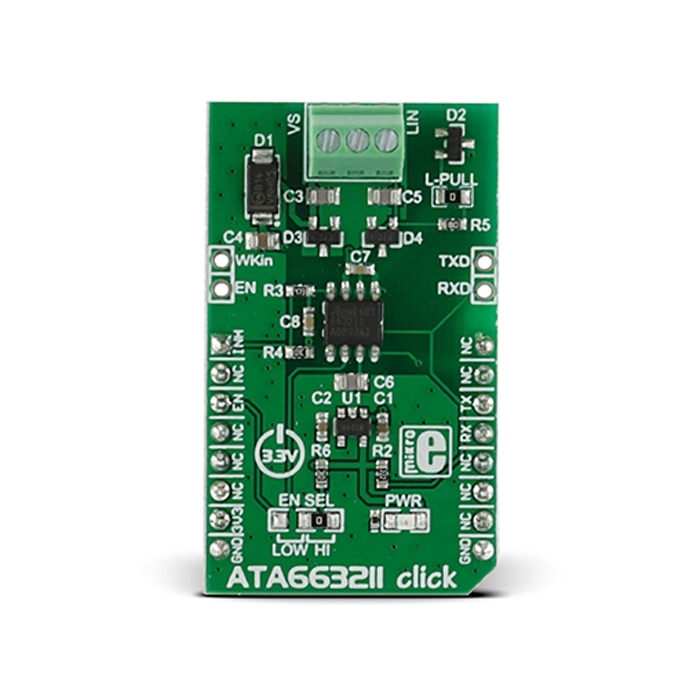MIKROE ATA663211 Click
The Click communicates with the target MCU through the UART interface and runs on a 3.3V power supply.
Product Overview
ATA663211 Click carries an Atmel LIN transceiver IC designed to handle low-speed data communication in vehicles and in industrial applications with electrically harsh environments. The LIN connection is established by attaching wires to the onboard screw terminals.
The Click communicates with the target MCU through the UART interface and runs on a 3.3V power supply.
ATA663211 Click can aslo be used as a standalone LIN transceiver, without being connected to a mikroBUS™ socket. An onboard LDO (low-dropout regulator) enables it to get its power supply through the VS line screw terminal.
LIN TRANSCEIVER
LIN or Local Interconnect Network is a protocol used for communicating between components in vehicles. These days cars have hundreds of sensor applications to measure things like temperature, pressure, air flow, speed, etc. All these applications need to communicate with the main system.
The LIN bus was created by European car manufactures in order to establish a new, uniform communication standard. It can be used with CAN (Controller Area Network), but LIN is more cost-effective for simple sensor networks in vehicles.
For more information see our Learn article on the LIN network protocol.
LOW CURRENT CONSUMPTION
The IC has three very low power modes: normal, sleep and fail-safe. In sleep mode the current consumption is typically 9μA – this is the lowest current consumption mode. It automatically switches to fail-safe mode at system power-up or after a wake-up event. In fail-safe mode it typically uses 80μA.
WHAT DOES A LIN TRANSCEIVER DO
LIN or Local Interconnect Network is a protocol used for communication between components in vehicles. The car industry has changed profoundly during this century. Cars have hundreds of sensor applications to measure things like temperature, pressure, air flow, speed, etc. All these applications need to communicate with the main system. The LIN bus was created by European car manufactures in order to establish a new, uniform communication standard. It can be used with CAN (Controller Area Network), but LIN is more cost-effective for simple sensor networks in vehicles.
But what is the difference between LIN and CAN network protocols? CAN is an a really complex interface, and with so many electronic components in a car the manufactures needed a cheaper alternative. The LIN interface is simpler than CAN — LIN uses a single wire communication and the slave nodes are clocked by only one master. CAN interface has nodes that can act independently, receive messages and act. It can have more than one master on the CAN bus. A LIN network is usually made of up to 16 nodes - one master and 15 slaves. This serial communications protocol is also well suited for other industrial applications with electrically harsh environments.
Features & Specs
- Interface: GPIO, UART
- Compatibility: mikroBUS™
- Dimensions: 42.9 x 25.4mm
- Input Voltage: 3.3V
Documentation
Customer Reviews





